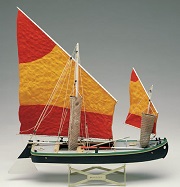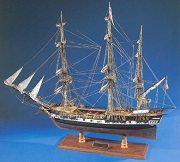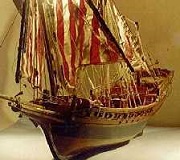Aeropiccola
 |
Het Italiaanse Aeropiccola is niet meer actief in de modelbouw wereld. Het uit Turijn afkomstige familiebedrijf had 60 jaar lang nationaal en internationaal succes. |
| Naam | Omschrijving | Afbeelding |
|---|---|---|
| Bragozzo | Bragozzo is the name of a very popular fishing boat used along the Adriatic coasts from the end of the 1700's to the beginning of 1900's. The boat had it's origins in the fishing village of Chioggia near Venice. It was then extended to other Adriatic coasts and modified according to local requirements. It had a very shallow draft and fairly flay bottom with a rudder which extended over a meter deep, but could be raised so that the boat could get into shallow water in case of a storm. The kit is single plank-on-bulkhead and includes all necessary laser cut bulkheads, wood planking, wood and metal fittings, sail cloth, rigging line, etc. Also included are detailed assembly plans, instructions, and the base board and pedestal shown in the pictures. Length 49cm (19.28") / Width 10cm (3.94") / Height 47.5cm (18.7") |  |
| Essex | The Essex was built in 1799 at Salem, Massachusetts by the famous shipbuilder Enos Briggs from a design by W. Hackett. At that time Essex was already a modern, fast and powerful ship, entirely different from other American frigates built previously. It's streamlined prow does not entirely match with the stern which is obviously in the Victorian style. The fore-deck and the quarter deck are two separate structures, accessible by foot walks along the side boards, but not level with the two decks. As a whole, the frigate could have looked like any other frigate engaged in the revolution, but with heavier armament, guns on its fore-deck and a much thinner shape. Essex distinguished herself winning many battles against the British Navy who subsequently captured her in the harbor at Valparaiso, Chile in 1814. After a quick transformation which brought her guns down to 46, they used her as a rank ship. This is how the ship is reproduced in Aeropiccola's kit. Aeropiccola's kit is plank-on-bulkhead construction. If the modeler wishes to finish the model in natural wood, sufficient walnut strips are included for a second layer of planking. Bulkheads are laser cut. Some parts must be cut from outlines using a fret saw or jewelers saw. Numerous copper, white metal, wood and brass fittings are included, including all armament. Also included are Aeropiccola's patented wood fibre parts including life boat, stern fittings, etc.Sail cloth is included as well as a stand (as the one pictured on the H.M.S. Swift. Complete instructions and a full set of plans should make this kit a pleasure to build. Length overall 109cm (42.91") Width 35cm (13.78") Height 74cm (29.13") |  |
| Indiscret | Historical information about this ship is very scarce in spite of deep research work based on ancient prints, books of the time and visits to museums. Anyway, the ship was built in France at the request of a nobleman, A.L. de Rouille, inspired by the famous corsair xebecs dominating the Northafrican coasts and raiding the French coasts with consequent destruction and death. The choice was the result of studies of the armed xebecs, some of them having even fought successfully against British ships. The practical results must have been satisfactory to the naval authorities of the time, as seven similar ships were built after her. The model reflects the results of research done to obtain as much information as possible about the ship. As with most of Aeropicolla's kits,double plank-on-bulkhead construction is possible with the materials supplied, or you can opt to paint the model after the first layer. Most parts are laser cut, and everything needed including all fittings, brass cannon etc. are included. The plans and instruction are excellent. Base board and pedestals show in the pictures are NOT included in the kit. Length 100cm (39.37") / Width 18cm (7.09") / Height 74cm (29.13") |  |
| Mayflower | On September 16, 1620 the Mayflower sailed from Plymouth harbor in England under the command of an ole whaler, carrying abut hundred passengers and a crew of fifty sailors, a huge load of furniture and domestic tools, goats and chickens, salted meat, vegetables, bread and other foodstuffs, including several casks of beer. Due to the navigational mistakes of an inexperienced pilot, the Mayflower passed the norther borders of Virginia by a least two hundred miles, and landed at the end of a long peninsula shaped like a fishing hook, Cape Cod in Massachusetts. William Brad ford described this event with a few unforgettable lines: "After crossing the vast ocean and a sea of misfortunes... they found neither friends to welcome them, nor hostels where to rest and refreshen their tired bodies, nor houses nor still any villages where to take shelter ..... they were told that if they were not going to find a suitable place soon they would have been landed with all their goods. However, these fathers' sons would have rightly said one day : "Our Fathers, the English who crossed the vast ocean, were ready to die in this savage world, but they prayed to God, and God listened to their voices giving heed to their adversities." Aeropiccola's kit of the Mayflower is double plank-on-bulkhead construction with laser cut bulkheads. All materials are furnished with many fittings in metal and brass as well as Aeropiccola's patented wood fibre. Excellent 1 to 1 plans and instructions make for an easy and enjoyable construction project. Sail cloth and stand shown in pictures are included. Length 80cm (31.5") / Width 33cm (12.99") / Height 64cm (25.2") |  |





